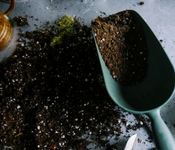| The secret life of soil |
 |
| Written by Lyn Dean |
| Wednesday, August 22, 2018 05:00 AM |
|
The best source of real food plants need to live lies within the soil. Plants crave fertile soil replete with small crawly and wiggly animals, weird-looking, barely visible fungi and microorganisms too small to see. Sadly, degraded soil worldwide has raised concerns about sustainability for food.
How soil health degrades “When soil is upended and meets the air, the organic matter in it decays faster and releases carbon in the form of CO2,” says David Montgomery, geologist and professor at University of Washington, in his book, Growing a Revolution: Bringing Our Soil Back to Life. Though fertilizer provides some basic nutrients as a temporary boost, soil really needs organic—meaning carbon-containing—material to maintain the complex community of living organisms. Why does this matter? It’s not about more carbon being released into the atmosphere. More important is the loss of carbon in the soil needed to feed the microbial life that keeps soil fertile and makes plants healthy. Soil fertility made easy Their three-part formula involves (1) minimal soil disturbance or tillage; (2) always keeping soil protected with cover crops and crop residue; and (3) diverse crop rotation. Locally, the Center for Root and Rhizosphere Biology at Colorado State University advocates that by “bringing together a combined understanding of root-microbiome interactions, we are likely to redefine the goals and practices of agricultural management and sustainability.” Soil restoration seems a simple and powerful way to sustainably support plant life. This article originally appeared in the July/August 2018 issue of Colorado Green magazine. Read the full issue online. Read more in this issue of Colorado Green NOW: |


